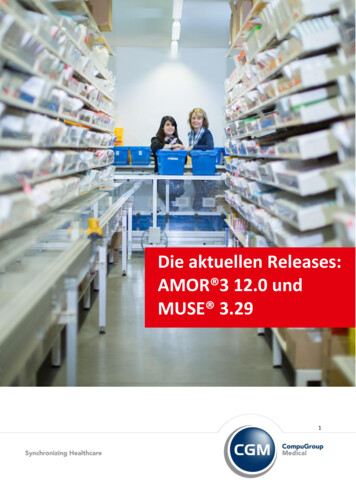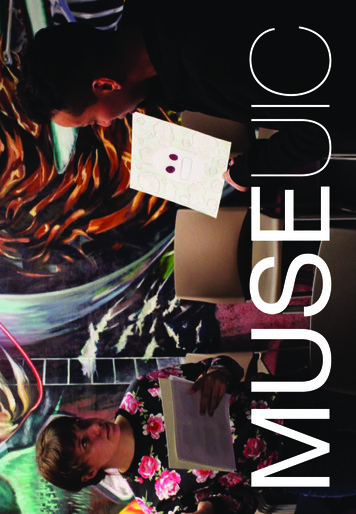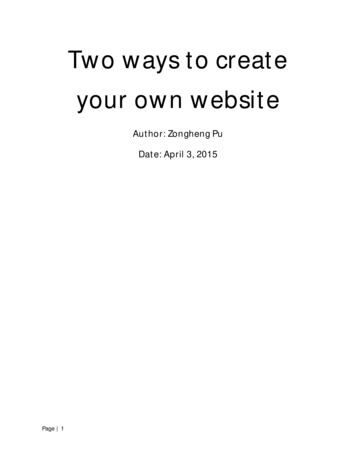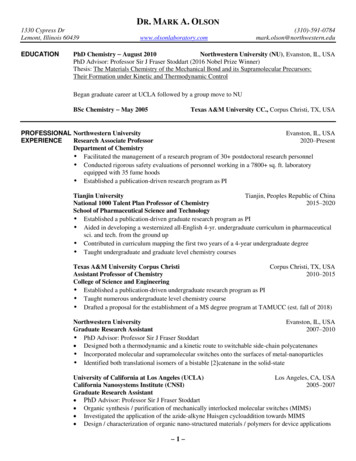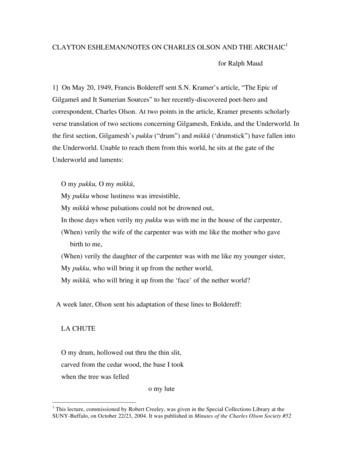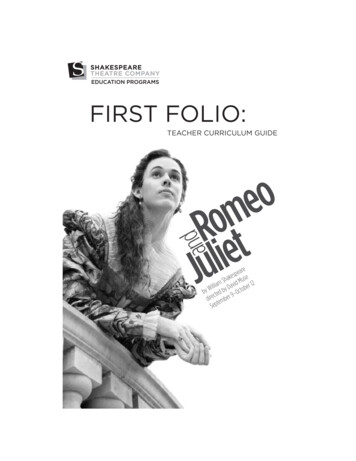
Transcription
Muse manualan authoring and publishing environmentfor GNU Emacs and XEmacs
This manual is for Emacs Muse version 3.12.Copyright c 2004, 2005, 2006, 2007, 2008 Free Software Foundation, Inc.Permission is granted to copy, distribute and/or modify this document underthe terms of the GNU Free Documentation License, Version 1.2 or any laterversion published by the Free Software Foundation; with no Invariant Sections,with the Front-Cover texts being “A GNU Manual”, and with the Back-CoverTexts as in (a) below. A copy of the license is included in the section entitled“GNU Free Documentation License” in this manual.(a) The FSF’s Back-Cover Text is: “You have freedom to copy and modifythis GNU Manual, like GNU software. Copies published by the Free SoftwareFoundation raise funds for GNU development.”This document is part of a collection distributed under the GNU Free Documentation License. If you want to distribute this document separately from thecollection, you can do so by adding a copy of the license to the document, asdescribed in section 6 of the license.All Emacs Lisp code contained in this document may be used, distributed, andmodified without restriction.
iTable of Contents1About the documentation . . . . . . . . . . . . . . . . . . . . . . 12What is Muse? . . . . . . . . . . . . . . . . . . . . . . . . . . . . . . . . . . 23How to Get Muse Releases and DevelopmentChanges . . . . . . . . . . . . . . . . . . . . . . . . . . . . . . . . . . . . . . . . 33.13.2Released versions of Muse . . . . . . . . . . . . . . . . . . . . . . . . . . . . . . . . . . . . . . 3Latest unreleased development changes . . . . . . . . . . . . . . . . . . . . . . . . . 34Compiling and Installing Muse . . . . . . . . . . . . . . . . 65Getting Started . . . . . . . . . . . . . . . . . . . . . . . . . . . . . . . . . 75.15.25.35.46How to Load Muse . . . . . . . . . . . . . . . . . . . . . . . . . . . . . . . . . . . . . . . . . . . . .How to Edit Files in Muse . . . . . . . . . . . . . . . . . . . . . . . . . . . . . . . . . . . . . .Publishing a Single File or Project. . . . . . . . . . . . . . . . . . . . . . . . . . . . . .Using a Different File Extension . . . . . . . . . . . . . . . . . . . . . . . . . . . . . . . .7788Creating and Managing Muse Projects . . . . . . . 96.16.26.36.4A Single-Project Example . . . . . . . . . . . . . . . . . . . . . . . . . . . . . . . . . . . . . . 9A Multiple-Project Example . . . . . . . . . . . . . . . . . . . . . . . . . . . . . . . . . . . . 9Publishing Subdirectories in Projects . . . . . . . . . . . . . . . . . . . . . . . . . . 10Listing of Available Options for Projects . . . . . . . . . . . . . . . . . . . . . . 107Keys Used in Muse Mode . . . . . . . . . . . . . . . . . . . . 138Rules for Using Markup . . . . . . . . . . . . . . . . . . . . . . .158.16Paragraphs: centering and quoting . . . . . . . . . . . . . . . . . . . . . . . . . . . .Levels of headings . . . . . . . . . . . . . . . . . . . . . . . . . . . . . . . . . . . . . . . . . . . . .Directives at the beginning of a document . . . . . . . . . . . . . . . . . . . . .Bold, italicized, and underlined text . . . . . . . . . . . . . . . . . . . . . . . . . . .Making notes to be shown at the end . . . . . . . . . . . . . . . . . . . . . . . . . .Indicating poetic stanzas . . . . . . . . . . . . . . . . . . . . . . . . . . . . . . . . . . . . . .Lists of items . . . . . . . . . . . . . . . . . . . . . . . . . . . . . . . . . . . . . . . . . . . . . . . . .Generation of data tables . . . . . . . . . . . . . . . . . . . . . . . . . . . . . . . . . . . . .Hyperlinks and email addresses with descriptions . . . . . . . . . . . . . .Bare URLs, WikiNames, and InterWiki links . . . . . . . . . . . . . . . . .Publishing and displaying images . . . . . . . . . . . . . . . . . . . . . . . . . . . . .Inserting a horizontal line or anchor . . . . . . . . . . . . . . . . . . . . . . . . . .Evaluating Emacs Lisp code in documents for extensibility. . . .Support for citing other resources . . . . . . . . . . . . . . . . . . . . . . . . . . . .Lines to omit from published output . . . . . . . . . . . . . . . . . . . . . . . . .Tags that Muse recognizes . . . . . . . . . . . . . . . . . . . . . . . . . . . . . . . . . . .15151616171717181919202121222323
ii9Publishing Various Types of Documents . . . . 279.1Integrating Muse and pyblosxom.cgi . . . . . . . . . . . . . . . . . . . . . . . . . . .9.1.1 Other tools needed for the Blosxom style . . . . . . . . . . . . . . . . .9.1.2 Format of a Blosxom entry and automation . . . . . . . . . . . . . . .9.1.3 Blosxom styles and options provided . . . . . . . . . . . . . . . . . . . . . .9.2 Publishing entries into a compilation . . . . . . . . . . . . . . . . . . . . . . . . . .9.3 Publishing ConTeXt documents . . . . . . . . . . . . . . . . . . . . . . . . . . . . . . .9.4 Publishing in DocBook XML form. . . . . . . . . . . . . . . . . . . . . . . . . . . . .9.5 Publishing in HTML or XHTML form . . . . . . . . . . . . . . . . . . . . . . . . .9.6 Integrating with ikiwiki . . . . . . . . . . . . . . . . . . . . . . . . . . . . . . . . . . . . . . .9.7 Keeping a journal or blog . . . . . . . . . . . . . . . . . . . . . . . . . . . . . . . . . . . . .9.8 Publishing LaTeX documents . . . . . . . . . . . . . . . . . . . . . . . . . . . . . . . . .9.9 Publish a poem to LaTeX or PDF . . . . . . . . . . . . . . . . . . . . . . . . . . . . .9.10 Publish entries to Texinfo format or PDF . . . . . . . . . . . . . . . . . . . .9.11 Publish entries to XML . . . . . . . . . . . . . . . . . . . . . . . . . . . . . . . . . . . . . .10Making your own publishing styles . . . . . . . . . 434445Specifying functions to mark up text . . . . . . . . . . . . . . . . . . . . . . . . .Markup rules for publishing . . . . . . . . . . . . . . . . . . . . . . . . . . . . . . . . . .Strings specific to a publishing style . . . . . . . . . . . . . . . . . . . . . . . . . .Tag specifications for special markup . . . . . . . . . . . . . . . . . . . . . . . . .Parameters used for defining styles . . . . . . . . . . . . . . . . . . . . . . . . . . .Deriving a new style from an existing one . . . . . . . . . . . . . . . . . . . .474749545455Miscellaneous add-ons, like a minor mode. . . . . . . . . . . . . . . . . . . . . . . . . . . . . . . . . . . . . . . . . . . . . . . . 5711.1Edit lists easily in other major modes . . . . . . . . . . . . . . . . . . . . . . . . 5712Getting Help and Reporting Bugs . . . . . . . . . . 5913History of This Document . . . . . . . . . . . . . . . . . . . 6114Contributors to This Documentation . . . . . . . 62Appendix A GNU Free Documentation License. . . . . . . . . . . . . . . . . . . . . . . . . . . . . . . . . . . . . . . . . . . . . . . . 63ADDENDUM: How to use this License for your documents . . . . . . . . . 69Index . . . . . . . . . . . . . . . . . . . . . . . . . . . . . . . . . . . . . . . . . . . . . . . 70
Chapter 1: About the documentation11 About the documentationThis document describes Muse, which was written by John Wiegley and is now maintainedby Michael Olson. Several versions of this manual are available on-line. PDF: http://mwolson.org/static/doc/muse.pdf HTML (single file): http://mwolson.org/static/doc/muse.html HTML (multiple files): http://mwolson.org/static/doc/muse/
Chapter 2: What is Muse?22 What is Muse?Emacs Muse (also known as “Muse” or “Emacs-Muse”) is an authoring and publishingenvironment for Emacs. It simplifies the process of writing documents and publishing themto various output formats.Muse consists of two main parts: an enhanced text-mode for authoring documents andnavigating within Muse projects, and a set of publishing styles for generating different kindsof output.What makes Muse distinct from other text-publishing systems is a modular environment,with a rather simple core, in which "styles" are derived from to create new styles. Much ofMuse’s overall functionality is optional. For example, you can use the publisher without themajor-mode, or the mode without doing any publishing; or if you don’t load the Texinfo orLaTeX modules, those styles won’t be available.The Muse codebase is a departure from emacs-wiki.el version 2.44. The code has beenrestructured and rewritten, especially its publishing functions. The focus in this revision ison the authoring and publishing aspects, and the "wikiness" has been removed as a defaultbehavior (available in the optional ‘muse-wiki’ module). CamelCase words are no longerspecial by default.One of the principal aims in the development of Muse is to make it very easy to producegood-looking, standards-compliant documents.
Chapter 3: How to Get Muse Releases and Development Changes33 How to Get Muse Releases and DevelopmentChanges3.1 Released versions of MuseChoose to install a release if you want to minimize risk.Errors are corrected in development first. User-visible changes will be announced onthe muse-el-discuss@gna.org mailing list. See Chapter 12 [Getting Help and ReportingBugs], page 59.Debian users can get Muse via apt-get. The ‘muse-el’ package is available both atMichael Olson’s APT repository and the official Debian repository. To make use of theformer, add the following line to your ‘/etc/apt/sources.list’ file and run apt-getinstall muse.deb http://mwolson.org/debian/ ./Ubuntu users can also get Muse via apt-get. The ‘muse-el’ package is available bothat Michael Olson’s APT repository and the official Ubuntu repository. To make use ofthe former, add the following line to your ‘/etc/apt/sources.list’ file and run apt-getinstall muse.deb http://mwolson.org/ubuntu/ ./The reason for making separate Debian and Ubuntu packages is that this manual is underthe GFDL, and Debian will not allow it to be distributed in its main repository. Ubuntu,on the other hand, permits this manual to be included with the ‘muse-el’ package.Alternatively, you can download the latest release from http://download.gna.org/muse-el/.3.2 Latest unreleased development changesChoose the development version if you want to live on the bleeding edge of Muse development or try out new features before release.The git version control system allows you to keep up-to-date with the latest changes tothe development version of Muse. It also allows you to contribute changes (via commits,if you are have developer access to the repository, or via patches, otherwise). If you wouldlike to contribute to Muse development, it is highly recommended that you use git.If you are new to git, you might find this tutorial helpful: ding the Muse module with git and staying up-to-date involves the followingsteps.1. Install git. Debian and Ubuntu: apt-get install git-core. Windows: http://git.or.cz/gitwiki/WindowsInstall. Other operating systems: download, compile, and install the source fromhttp://www.kernel.org/pub/software/scm/git/, or find a git package foryour operating system.2. Download the Muse development branch.If you have developer access to Muse, do:
Chapter 3: How to Get Muse Releases and Development Changes4git clone ssh://repo.or.cz/srv/git/muse-el.git museotherwise, do:git clone git://repo.or.cz/muse-el.git museIf you are behind a restrictive firewall, and do not have developer access, then do thefollowing instead:git clone http://repo.or.cz/r/muse-el.git muse3. List upstream changes that are missing from your local copy. Do this whenever youwant to see whether new changes have been committed to Muse. If you wish, you mayskip this step and proceed directly to the “update” step.# Change to the source directory you are interested in.cd muse# Fetch new changes from the repository, but don’t apply them yetgit fetch origin# Display log messages for the new changesgit log HEAD.origin“origin” is git’s name for the location where you originally got Muse from. You canchange this location at any time by editing the ‘.git/config’ file in the directorywhere the Muse source was placed.4. Update to the latest version by pulling in any missing changes.cd musegit pull origingit will show how many files changed, and will provide a visual display for how manylines were changed in each file.There are other ways to interact with the Muse repository. Browse git repo: http://repo.or.cz/w/muse-el.git Latest development snapshot: http://mwolson.org/static/dist/muse-latest.tar.gz Latest development snapshot (zip file): http://mwolson.org/static/dist/muse-latest.zipThe latest development snapshot can lag behind the git repo by as much as 20 minutes,but never more than that.Becoming a Muse developerIf you want commit access to the shared Muse repository, then register an account athttp://repo.or.cz (be sure to add an SSH key), and contact the current maintainer atmwolson@gnu.org. It would be best to send some patches to the muse-el-discuss@gna.orgmailing list first, so that he knows that you know what you are doing. See Chapter 12[Getting Help and Reporting Bugs], page 59, for instructions on subscribing to the mailinglist.You must also be willing to sign a copyright assignment for your changes to Muse, sinceMuse is a GNU project. The current maintainer will assist you in this process if you contacthim.
Chapter 3: How to Get Muse Releases and Development Changes5For information on committing changes to Muse and performing development, pleaseconsult http://emacswiki.org/cgi-bin/wiki/MuseDevelopment.
Chapter 4: Compiling and Installing Muse64 Compiling and Installing MuseMuse may be compiled and installed on your machine.CompilationThis is an optional step, since Emacs Lisp source code does not necessarily have to bebyte-compiled. Byte-compilation may yield a very slight speed increase.A working copy of Emacs or XEmacs is needed in order to compile Emacs Muse. Bydefault, the program that is installed with the name emacs will be used.If you want to use the xemacs binary to perform the compilation, you must copy‘Makefile.defs.default’ to ‘Makefile.defs’ in the top-level directory, and then edit‘Makefile.defs’ as follows. You can put either a full path to an Emacs or XEmacs binaryor just the command name, as long as it is in the PATH.EMACS xemacsSITEFLAG -no-site-file# Edit the section as necessaryinstall info install-info --section "XEmacs 21.4" (1).info \ (INFODIR)/dir :Running make in the top-level directory should compile the Muse source files in the‘lisp’ directory, and generate an autoloads file in ‘lisp/muse-autoloads.el’.InstallationMuse may be installed into your file hierarchy by doing the following.Copy ‘Makefile.defs.default’ to ‘Makefile.defs’ in the top-level directory, if youhaven’t done so already. Then edit the ‘Makefile.defs’ file so that ELISPDIR points towhere you want the source and compiled Muse files to be installed and INFODIR indicateswhere to put the Muse manual. You may use a combination of DESTDIR and PREFIX tofurther determine where the installed files should be placed. As mentioned earlier, you willwant to edit EMACS and SITEFLAG as shown in the Compilation section if you are usingXEmacs.If you are installing Muse on a Debian or Ubuntu system, you might want to change thevalue of INSTALLINFO as specified in ‘Makefile.defs’.If you wish to install Muse to different locations than the defaults specify, edit‘Makefile.defs’ accordingly.Run make as a normal user, if you haven’t done so already.Run make install as the root user if you have chosen installation locations that requireroot permissions.ELPAFor those used to installing software packages, there will be a muse package available in theEmacs Lisp Package Archive (abbreviated “ELPA”) as of the 3.10 release of Muse. Thispackage will be compiled and installed automatically in a user-specific location. For moreinformation on ELPA, see http://tromey.com/elpa/.
Chapter 5: Getting Started75 Getting Started5.1 How to Load MuseTo use Muse, add the directory containing its files to your load-path variable, in your‘.emacs’ file. Then, load in the authoring mode, and the styles you wish to publish to. Anexample follows.(add-to-list ’load-path " path to Muse ")(require ’muse-mode); load authoring mode(require(require(require(require; load publishing styles I use-docbook)(require ’muse-project) ; publish files in projectsAn easy way of seeing which settings are available and changing settings is to use theMuse customization interface. To do this, type M-x customize-group muse RET. Each ofthe options has its own documentation. Options are grouped logically according to whateffect they have.5.2 How to Edit Files in MuseMuse Mode should automatically be activated when you visit a file with a “.muse” extension.One such file is ‘QuickStart.muse’, which is available in the ‘examples’ directory of theMuse distribution. You can tell that Muse Mode has been activated by checking for thetext “Muse” in your mode line. If Muse Mode has not been activated, you may activate itby type M-x muse-mode RET.You will notice that Muse files are highlighted very simply. Links are colored blue,headings are large and bold text, and example tags are colored in grey.There are several different ways to edit things like links, which hide the underlyingMuse markup. One way is to toggle font-locking off by hitting C-c C-l, which is also M-xfont-lock-mode, make changes, and then hit C-c C-l again to toggle font-locking back on.Another way is just to move into the text and edit it. Markup can also be removed bynormal deletion methods, though some side effects might require a second deletion.For the particular case of editing links, it is easiest to move to the link and do C-cC-e, which is also M-x muse-edit-link-at-point. This prompts you for the link and itsdescription, using the previous contents of the link as initial values. A link to another Musefile may be created by hitting C-c TAB l. A link to a URL may be created by hitting C-cTAB u. Links may be followed by hitting RET on them.If you want to add a new list item, this may by accomplished by hitting M-RET. This willput a dash and some spaces on the screen. The dash is the Muse markup that indicates alist item. It is also possible to created “nested” lists with this command, by adjusting thenumber of spaces in front of the dashes. If you have lists with long lines, you can move toa list item and hit M-q to wrap it onto multiple lines.
Chapter 5: Getting Started85.3 Publishing a Single File or ProjectThe command M-x muse-project-publish-this-file will publish the current documentto any available publishing style (a publishing style is an output format, like HTML orDocbook), placing the output in the current directory. If you are in Muse Mode, thiscommand will be bound to C-c C-t. If the file has been published recently, and its contentshave not changed, running C-c C-t again will not publish the file. To force publishing inthis case, do C-u C-c C-t.If you have set up projects and are visiting a file that is part of a project, then C-c C-t willrestrict the output formats to those which are used by the project, and will automaticallypublish to the output directory defined by the project. If you want to publish to a differentdirectory or use a different format, then use C-c M-C-t, which is also M-x muse-publishthis-file.If the currently opened file is part of a defined project in muse-project-alist, it (andthe rest of the changed files in a project) may be published using C-c C-p.5.4 Using a Different File ExtensionBy default, Muse expects all project files to have the file extension ‘.muse’. Files withoutthis extension will not be associated with Muse mode and will not be considered part ofany project, even if they are within a project directory.If you don’t want to use ‘.muse’, you can customize the extension by setting the valueof muse-file-extension.If you don’t want to use any extension at all, and want Muse to autodetect project filesbased on their location, then add the following to your Muse settings file.(setq muse-file-extension nilmuse-mode-auto-p t)Note that if you chose to have muse-file-extension set to nil, you may have troubleif your ‘.emacs’ file or other init scripts attempt to visit a Muse file. (A very commonexample of this is if you use Planner with Muse and run (plan) from your ‘.emacs’.) Ifyou wish to visit Muse files from your ‘.emacs’, be sure to also add the following additionalcode before any such visits happen:(add-hook ’find-file-hooks ’muse-mode-maybe)
Chapter 6: Creating and Managing Muse Projects96 Creating and Managing Muse ProjectsOften you will want to publish all the files within a directory to a particular set of outputstyles automatically. To support, Muse allows for the creation of "projects".6.1 A Single-Project ExampleHere is a sample project, which may be defined in your ‘.emacs’ file.(setq muse-project-alist’(("Website" (" /Pages" :default "index")(:base "html" :path " /public html")(:base "pdf" :path " /public html/pdf"))))The above defines a project named "website", whose files are located in the directory‘ /Pages’. The default page to visit is ‘index’. When this project is published, each pagewill be output as HTML to the directory ‘ /public html’, and as PDF to the directory‘ /public html/pdf’. Within any project page, you may create a link to other pages usingthe syntax ‘[[pagename]]’.If you would like to include only some files from a directory in a Muse project, you mayuse a regexp in place of ‘ /Pages’ in the example.6.2 A Multiple-Project ExampleIt is possible to specify multiple projects. Here is an example of three projects: a genericwebsite, a projects area, and a day-planner (the day-planner part requires Planner Mode—see http://wjsullivan.net/PlannerMode.html to get it).(setq muse-project-alist’(("Website" (" /Pages" :default "index")(:base "html" :path " /public html"))(("Projects" (" /Projects" :default "index")(:base "xhtml":path " /public html/projects":exclude "/TopSecret")(:base "pdf":path " /public html/projects/pdf":exclude "/TopSecret")))("Plans" (" /Plans":default "TaskPool":major-mode planner-mode:visit-link planner-visit-link)(:base "planner-xhtml":path " /public html/plans"))))The ‘:major-mode’ attribute specifies which major to use when visiting files in thisdirectory.The ‘:visit-link’ attribute specifies the function to call when visiting links.The ‘:exclude’ attribute has a regexp that matches files to never publish.
Chapter 6: Creating and Managing Muse Projects106.3 Publishing Subdirectories in ProjectsIf you want to publish a directory and all of its subdirectories, Muse provides two convenience functions that together generate the proper rules for you. Note that we use thebacktick to begin this muse-project-alist definition, rather than a single quote.(setq muse-project-alist‘(("Website" (" /Pages" :default "index")(:base "html" :path " /public html"))("Blog" (,@(muse-project-alist-dirs " /Blog"):default "index");; Publish this directory and its subdirectories. Arguments;; are as follows. The above ‘muse-project-alist-dirs’ part;; is also needed.;;1. Source directory;;2. Output directory;;3. Publishing style;;remainder: Other things to put in every generated style,@(muse-project-alist-styles " /Blog"" /public html/blog""blosxom"))))The muse-project-alist-dirs function takes a directory and returns it and all of itssubdirectories in a list.The muse-project-alist-styles function is explained by the comments above.The “blosxom” text is the name of another publishing style, much like “html”. SeeSection 9.1 [Blosxom], page 27, for further information about it. You can use any publishingstyle you like for the third argument to muse-project-alist-styles.6.4 Listing of Available Options for ProjectsThis is a listing of all of the various options (or, more accurately: attributes) that may bespecified in muse-project-alist.Each muse-project-alist entry looks like this:(PROJECT-NAME (SOURCES)OUTPUTS)We refer to these names below.“Attributes”, which compose SOURCES and OUTPUTS, are a pair of values. The firstvalue is a keyword, like ‘:default’. The second part is the value associated with thatkeyword, such as the text “index”. If you are familiar with Emacs Lisp property lists, theconcept is similar to that, except that in the SOURCES section, single directories can beinterspersed with two-value attributes.Project NameThis is a string that indicates the name of the project. It is primarily used for publishinginterwiki links with the ‘muse-wiki.el’ module.
Chapter 6: Creating and Managing Muse Projects11SourcesThis part of a muse-project-alist entry consists of two-value attributes, and also directorynames. If you are publishing a book, the order of directories and attributes is significant.The minimal content for the sources section is a list of directories.‘:book-chapter’Indicates a new chapter of a book. The text of the title of the chapter comesimmediately after this keyword.‘:book-end’Indicates the end of a book. Directories listed after this one are ignored whenpublishing a book. The value “t” (without quotes) should come immediatelyafter this keyword.‘:book-funcall’A function to call while publishing a book. This is useful for doing somethingjust after a particular chapter.‘:book-part’Indicates the beginning of a new part of the book. The text of the title shouldcome immediately after this keyword.‘:book-style’Indicate a particular publishing style to use for this part of the book. If this isspecified, it should come just after a ‘:part’ attribute.‘:default’The default page to visit when browsing a project. Also, if you are using the‘muse-wiki.el’ module, publishing a link to just a project’s name will cause itto link to this default file.‘:force-publish’This specifies a list of pages which should be published every time a project ispublished (by using C-c C-p, for example), regardless of whether their contentshave changed. This is useful for updating Index pages, pages that use the include tag, and other pages that have dynamically-generated content.‘:major-mode’This specifies the major mode to use when visiting files in this project. Thedefault is muse-mode.‘:nochapters’This indicates that while publishing a book, do not automatically create chapters. Values which may follow this are nil (the default, which means that weautomatically create chapters), or non-nil, which means that we manually specify chapters with the ‘:book-chapter’ attribute,‘:publish-project’Indicates which function we should call when publishing a project.‘:set’This specifies a list of variables and values to set when publishing a project.The list should be a property list, which is in the form:
Chapter 6: Creating and Managing Muse Projects12(VAR1 VALUE1 VAR2 VALUE2 .)‘:visit-link’Specifies the function to call when visiting a link. The default is muse-visitlink-default. The arguments for that function should be (1) the link and (2)whether to visit the link in a new window.OutputsThis part of a muse-project-alist entry is composed of lists of attributes. Each list is calledan “output style”.The minimal content for an output style is a ‘:base’ attribute and a ‘:path’ attribute.‘:base’Publishing style to use, such as “html”, “docbook”, or “pdf”.‘:base-url’An external URL which can be used to access published files. This is mainlyused by the ‘muse-wiki’ module when publishing links between two separateprojects, if the projects are served on different domains.It is also used by the ‘muse-journal’ module to create the RSS or RDF output.‘:exclude’Exclude items matching a regexp from being published. The regexp shouldusually begin with "/".‘:include’Only include items matching a regexp when publishing. The regexp shouldusually begin with "/".‘:path’The directory in which to store published files.‘:timestamps’A file containing the timestamps (that is, time of creation) for files in thisproject. It might eventually used by the ‘muse-blosxom’ module, but thisoption is not currently in use by any Muse code.
Chapter 7: Keys Used in Muse Mode137 Keys Used in Muse ModeThis is a summary of keystrokes available in every Muse buffer.C-c C-a (‘muse-index’)Display an index of all known Muse pages.C-c C-b (‘muse-find-backlinks’)Find all pages that link to this page.C-c C-e (‘muse-edit-link-at-point’)Edit link at point.C-c C-f (‘muse-project-find-file’)Open another Muse page. Prompt for the name.C-c C-i l, C-c TAB l (‘muse-insert-relative-link-to-file’)Insert a link to a file interactively.C-c C-i t, C-c TAB t (‘muse-insert-tag’)Insert a tag interactively.C-c C-i u, C-c TAB u (‘muse-insert-url’)Insert a URL interactively.C-c C-l (‘font-lock-mode’)Toggle font lock / highlighting for the current buffer.C-c C-p (‘muse-project-publish’)Publish any Muse pages that have changed.C-c C-s (‘muse-search’)Find text in all files of the current project.C-c C-t (‘muse-project-publish-this-file’)Publish the currently-visited file. Prompt for the style if the current file can bepublished using more than one style.C-c C-S-t, or C-c C-M-t (‘muse-publish-this-file’)Publish the currently-visited file. Prompt for both the style and output directory.C-c C-v (‘muse-browse-result’)Show the published result of this page.C-c (‘muse-what-changed’)Diff this page against the last backup version.TABMove to the next Wiki reference.S-TABMove to the previous Wiki reference.M-TABComplete the name of a page from the current project at point.M-RETInsert a new list item at point, indenting properly.C- Decrease the indentation of the list item at point.
Chapter 7: Keys Used in Muse ModeC- Increase the indentation of the list item at point.M-x muse-colors-toggle-inline-images RETToggle display of inlined images on/off.M-x muse-update-values RETUpdate various values that are automatically generated.Call this after changing muse-project-alist.14
Cha
Muse consists of two main parts: an enhanced text-mode for authoring documents and navigating within Muse projects, and a set of publishing styles for generating different kinds of output. What makes Muse distinct from other text-publishing systems is a modular environment,

